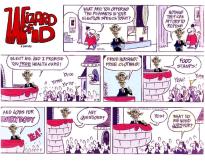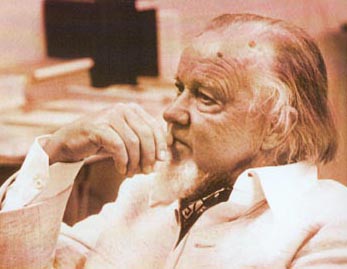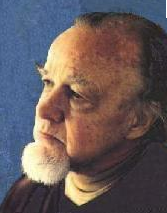Below you will see more about my pro-life views and also those of Joe Biden.
Have you ever tried having a conversation with a deeply committed liberal? Does it feel like you’re having a conversation with a religious zealot? Well, Dr. Albert Mohler gives us some insight on exactly why it feels that way. Secularism, it seems, is a religion, complete with scriptures, dogmas, priests, a list of sins, and a sacerdotal elite. These people won’t even consider an opposing viewpoint. If they profess to be Christians, they will just throw their Christian “faith” into an upper storage compartment, and affirm they personally believe in core Christian doctrines, but that those beliefs are private, and personal. The VP debate proves that liberals can compartmentalize their Christian faith from their Secularist faith:
“Well, maybe the title should be one Catholic guy talks about these issues while the other Catholic guy interrupts, mumbles, mugs for the camera, and manages to worry anyone who recalls that he’s one heartbeat away from the Presidency. That’s hard to fit into a headline, though, so we’ll just have to make do. Paul Ryan and Joe Biden got this question from Martha Raddatz on faith and abortion almost at the end of the debate, as she noted that this was the first time two Catholics have squared off in these forums. Ryan gives a personal defense of his opposition to abortion and ties it explicitly to his faith, while Biden, er … compartmentalizes:
Sorry, but speaking as a Catholic, Biden’s answer was nonsense, as was his attempt to interrupt Ryan with some scolding on “social justice.” That’s not to say that Catholics have no objections to Ryan on that score — they certainly do, although Ryan’s bishop defended at least Ryan’s intent and spirit on his budget proposals. But the entire Catholic mission of social justice rests on the sacredness of individual human life, beginning at conception — as Biden himself acknowledges in this debate.
The point of social justice is to recognize the sanctity of each human life and act to protect it, be that through shelter, healing, food, and a number of other ways. However, the most defenseless of all human life is that of the unborn. Furthermore, while one can argue to what extent government should be involved in charitable efforts, the basic function of government is to protect the lives of its people. Social justice cannot begin without protecting unborn human life (and it can’t end there, either). That, as Catholics know, is one of the major aspects of the “seamless garment” of Catholic social teaching.
It’s nonsense to say as a government official that you believe that human life starts at conception but that you can’t act to protect it. Certainly many people believe that human life does not start at conception, but that’s less science- and reason-based than the Catholic doctrine that opposes it. At least, though, that belief doesn’t have that inherent contradiction that Biden expressed last night.
via http://hotair.com/archives/2012/10/12/video-two-catholic-guys-talk-about-abortion-faith-and-religious-liberty/
It was Francis Schaeffer who reminded us of this Existential compartmentalization, and the liberal’s Kierkegaardian “leap of faith. Greg Koukl capture this best:
“This is a textbook case of what the late Dr. Francis Schaeffer called an upper story leap. What he described in his book Escape From Reason –which is a short book and is worthy of being read if you want to understand why people think the way this rabbi thinks–is that in the realm of facts and history and science–in other words, all that is measurable–we come up with a conclusion that man is meaningless. Life is meaningless. We are caught in a cause and effect naturalistic system. We are part of the machine. That’s the fact of the matter. That’s what science tells us. Because that is hard to handle, we make what Kierkegaard called a leap of faith and we leap into the upper story of faith and significance. So we make a theological statement of faith that we are valuable and we are worthwhile. Here’s what’s important. The statement about value that we are assuming based on belief in the Bible has nothing to do with reality. That’s why modern religious thinkers who think this way are schizophrenic. They can’t defend their faith in the real world because the point is there is no defense in the real world. The real world speaks against value in human beings so we must take a leap of faith.“
via http://www.str.org/site/News2?page=NewsArticle&id=5667
Dr. Mohler quotes Howard P. Kainz, professor emeritus of philosophy at Marquette University, frequently in the following segment:
“Kainz offers a crucial insight here. He suggests that one of the most important factors in the nation’s cultural divide is that persons on both sides are deeply committed to their own creeds and worldviews — even if on one side those creeds are secular.
(Secularist liberals have a creed.)
“This explains why talking about abortion or same-sex ‘marriage,’ for example, with certain liberals is usually futile. It is like trying to persuade a committed Muslim to accept Christ. Because his religion forbids it, he can only do so by converting from Islam to Christianity; he cannot accept Christ as long as he remains firmly committed to Islam. So it is with firmly committed liberals: Their ‘religion’ forbids any concessions to the ‘conservative’ agenda, and as long as they remain committed to their secular ideology, it is futile to hope for such concessions from them.”
(Or as the Ferengi Grand Magus Zek complains on Star Trek Deep Space Nine: “it’s like arguing with a Klingon… Yes, I am a trekkie)
Kainz’s argument bears similarities not only to Machen’s observations about the theological scene, but also to Thomas Sowell’s understanding of the larger culture. As Sowell argued in A Conflict of Visions, the basic ideological divide of our times is between those who hold a “constrained vision” over those who hold an “unconstrained vision.” Both worldviews are, in the actual operations of life, reduced to certain “gut feelings” that operate much like religious convictions.
(It boils down to presuppositions)
Kainz concedes that some will resist his designation of secularism as a religion. “Religion in the most common and usual sense connotes dedication to a supreme being or beings,” he acknowledges. Nevertheless, “especially in the last few centuries, ‘religion’ has taken on the additional connotations of dedication to abstract principles or ideals rather than a personal being,” he insists. Kainz dates the rise of this secular religion to the French Enlightenment and its idolatrous worship of reason.
(This “reason” is completely materialistic, and can never move beyond the confines of the physical universe. There is no Special Revelation, and no way to logically move from physics into metaphysics.)
Looking back over the last century, Kainz argues that Marxism and ideological Liberalism have functioned as religious systems for millions of individuals. Looking specifically at Marxism, Kainz argues that the Marxist religion had dogmas, canonical scriptures, priests, theologians, ritualistic observances, parochial congregations, heresies, hagiography, and even an eschatology. Marxism’s dogmas were its core teachings, including economic determinism and the “dictatorship of the proletariat.” Its canonical scriptures included the writings of Marx, Lenin, and Mao Tse Tung. Its priests were those guardians of Marxist purity who functioned as the ideological theorists of the movement. Its ritualistic observances included actions ranging from workers’ strikes to mass rallies. The eschatology of Marxism was to be realized in the appearance of “Communist man” and the new age of Marxist utopia.
Similarly, Kainz argues that modern secular liberalism includes its own dogmas. Among these are the beliefs “that mankind must overcome religious superstition by means of reason; that empirical science can and will eventually answer all the questions about the world and human values that were formerly referred to traditional religion or theology; and that the human race, by constantly invalidating and disregarding hampering traditions, can and will achieve perfectibility.”
(It’s the Utopian dream of optimistic human progress, devoid of any understanding of man’s sin, rebellion, and need of an Intermediary between God and man.)
Kainz also argues that contemporary liberalism has borrowed selectively from the New Testament, turning Jesus’ admonition to “render unto Caesar what is Caesar’s, and to God what is God’s,” as a foundation for “absolute secularism,” enshrined in the language of a wall separating church and state. Thus, “religion [is] reduced to something purely private.”
(This is why groups like the Freedom From Religion are using the billy club of “separation of church and state” to marginalize and Christian expression in this nation. Even the POTUS changed “freedom of religion” to “freedom of worship”. It’s a subtle attempt to grant religious expression only in our houses of worship. Otherwise, keep your non-secular ideas to yourself.)
Secular liberalism also identifies certain sins such as “homophobia” and sexism. As Kainz sees it, the secular scriptures fall into two broad categories: “Darwinist and scientistic writings championing materialist and naturalistic explanations for everything, including morals; and feminist writings exposing the ‘evil’ of patriarchy and tracing male exploitation of females throughout history up to the present.”
(What are the new “Commandments” of Liberalism (whether Modern, or Postmodern)? How about evolution, same-sex marriage, secular feminism, environmentalism, the “green” movement, Moral Relativism, etc.)
The priests and priestesses of secular liberalism constitute its “sacerdotal elite” and tend to be intellectuals who can present liberal values in the public square. Congregations where secular liberals gather include organizations such as Planned Parenthood, the ACLU, the National Organization of Women, and similar bodies. These groups “help supply a sense of affiliation and commonality for the religiously liberal.”
(The use of para-religious liberal groups to further their agenda.)
The rites and rituals of secular liberalism include “gay pride” parades and pro-abortion rallies. Interestingly, the eschatology of this movement is, Kainz argues, the distillation of pragmatism. “In the estimation of the religiously liberal,” Kainz asserts, “all lifestyles and all moralities can approximate this goal, as long as the proscribed illiberal ’sins’ are avoided.”
(Their eschatology is pragmatism: the “ends justifies the means”, and “whatever works”. Their prophet is Saul Alinsky.)
Kainz readily admits that not all liberals are committed to this religious vision of liberalism. As he sees it, “There are many people working for social justice, human rights, international solidarity, and other causes commonly regarded as liberal without a deep ideological commitment.” His point is that conservatives may find common cause and common ground with these non-religiously committed liberals.
(We can and should find common ground with moderate liberals. After all, we share a social concern with them. We, too, as Christians, care about the poor, and we are called to steward this world responsibly. there are many social and political issues we can work cooperatively with liberals to accomplish. It’s practically impossible to work with religious secular liberals on any thing.)
“For many ‘moderate’ liberals, liberalism is a political perspective, not a core ideology,” he observes. “In the culture war it is important for Christians to distinguish between the religiously committed liberal and the moderate liberal. For one thing, Christians should not be surprised when they find no common ground with the former. They may form occasional, even if temporary, alliances with the latter.”
Kainz’s article “Liberalism as Religion: The Culture War Is Between Religious Believer on Both Sides,” appears in the May 2006 edition of Touchstone magazine. His analysis is genuinely helpful in understanding the clash of positions, policies, convictions, and visions that mark our contemporary scene.
Though Kainz does not develop this point, all persons are, in their own way, deeply committed to their own worldview. There is no intellectual possibility of absolute value neutrality — not among human beings, anyway.
The conception of our current cultural conflict as a struggle between two rival religions is instructive and humbling. At the political level, this assessment should serve as a warning that our current ideological divides are not likely to disappear anytime soon. At the far deeper level of theological analysis, this argument serves to remind Christians that evangelism remains central to our mission and purpose. Those who aim at the merely political are missing the forest for the trees, and confusing the temporal for the eternal.
Two rival religions? Machen was right then, and he is right now. The real struggle is between Christianity and Post-Christianity.”
via AlbertMohler.com – Two Rival Religions? Christianity and Post-Christianity.
The only way to effectively change a culture is to make them disciples of Jesus Christ. Share your faith with whoever will listen, and yes, that means even those aggravating secular-religious liberals that drive you nuts. Love them in Jesus’ Name.
simul iustus et peccator,
Eric Adams
Thank you so much for your time. I know how valuable it is. I also appreciate the fine family that you have and your commitment as a father and a husband.
Everette Hatcher III, 13900 Cottontail Lane, Alexander, AR 72002, ph 501-920-5733, lowcostsqueegees@yahoo.com


















